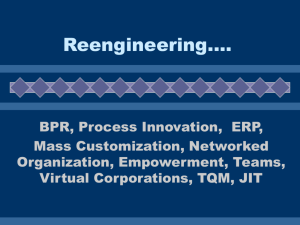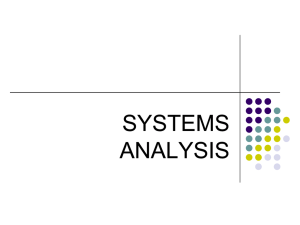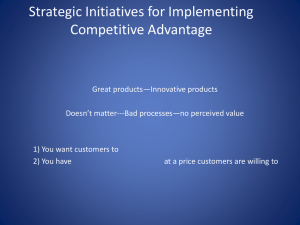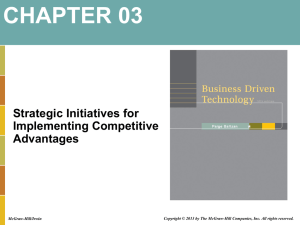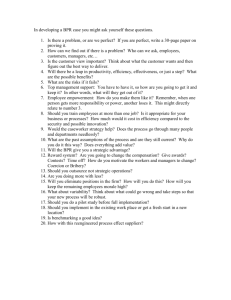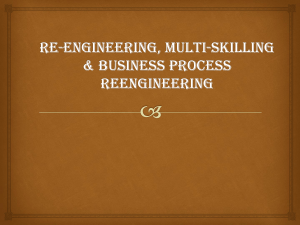CH02.2 (1)
advertisement
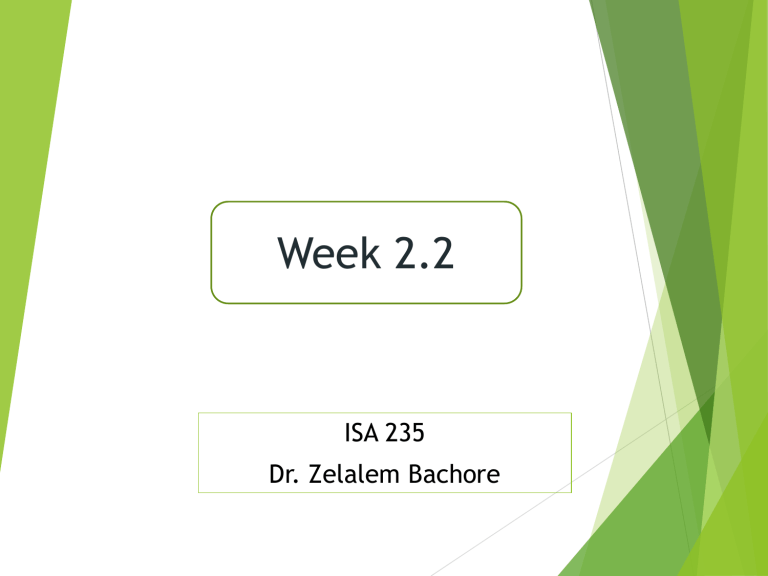
Week 2.2 ISA 235 Dr. Zelalem Bachore SECTION 2.2 BUSINESS PROCESSES CHAPTER TWO OVERVIEW SECTION 2.1 – Decision Support Systems (DSS) Making Organizational Business Decisions Measuring Organizational Business Decisions Using MIS to Make Business Decisions Using AI to Make Business Decisions SECTION 2.2 – Business Processes Managing Business Processes Business Process Modeling Using MIS to Improve Business Processes BUSINESS PROCESS MODELING Business process modeling (or visual mapping): The activity of creating a detailed flow chart or process map of a work process showing its inputs, tasks, and activities, in a structured sequence Communication Documentation Analysis (e.g. simulation) Business Process Model and Notation BPMN from 10,000 miles… A BPMN process model is a graph consisting of four types of core elements/notations: end start activity event Gateway/Decision sequence flow Filling Customers Order Reject order Items not in stock Check Check stock stock availability Purchase order received Items in stock Confirm order Emit invoice Ship goods Archive order Order fulfilled BUSINESS PROCESS MODELING • As-Is process model: Represents the current state of the operation that has been mapped, without any specific improvements or changes to existing processes. • To-Be process model: Shows the results of applying change improvement opportunities to the current (As-Is) process model. BUSINESS PROCESS MODELING USING MIS TO IMPROVE BUSINESS PROCESSES Business process improvement attempts to understand and measure the current process and make performance improvements accordingly. Three primary types of business process change available to firms and the business areas in which they are most often effective OPERATIONAL BUSINESS PROCESSES AUTOMATION Automation – The process of computerizing manual tasks Operational business processes are static, routine, daily business processes such as stocking inventory, checking out customers, or daily opening and closing processes. OPERATIONAL BUSINESS PROCESSES AUTOMATION Steps in Business Process Improvement MANAGERIAL BUSINESS PROCESSES STREAMLINING Managerial business processes are semi-dynamic, semi-routine, monthly business processes such as resource allocation, sales strategy, or manufacturing process improvements Streamlining – Improves business process efficiencies by simplifying or eliminating unnecessary steps Bottleneck – Occur when resources reach full capacity and cannot handle any additional demands Redundancy – Occurs when a task or activity is unnecessarily repeated e.g. if both sales and accounting check customer credit!! STRATEGIC BUSINESS PROCESSES REENGINEERING Strategic business processes are dynamic, nonroutine, long-term business processes such as financial planning, expansion strategies, and stakeholder interactions. Business process reengineering (BPR) Analysis and redesign of workflow within and between enterprises Find a completely different approach!! STRATEGIC BUSINESS PROCESSES REENGINEERING A company can improve the way it travels the road by moving from foot to horse and then horse to car automation and streamline BPR looks at taking a different path, such as an airplane which ignore the road completely Assignment#6: Re-engineering & BPMN STRATEGIC BUSINESS PROCESSES REENGINEERING • A company could improve the way it travels by changing from foot to horse and then from horse to car. • With a BPR mind-set, however, it would look beyond automating and streamlining to find a completely different approach. • It would ignore the road and travel by air to get from point A to point B Business process reengineering (BPR) - Analysis and redesign of workflow within and between enterprises Reading Assignment! 1.Metrics 2.Business Process 3.Best Practices 4.Model 5.Granularity 6.Visualization Read Chapter 02. 15

